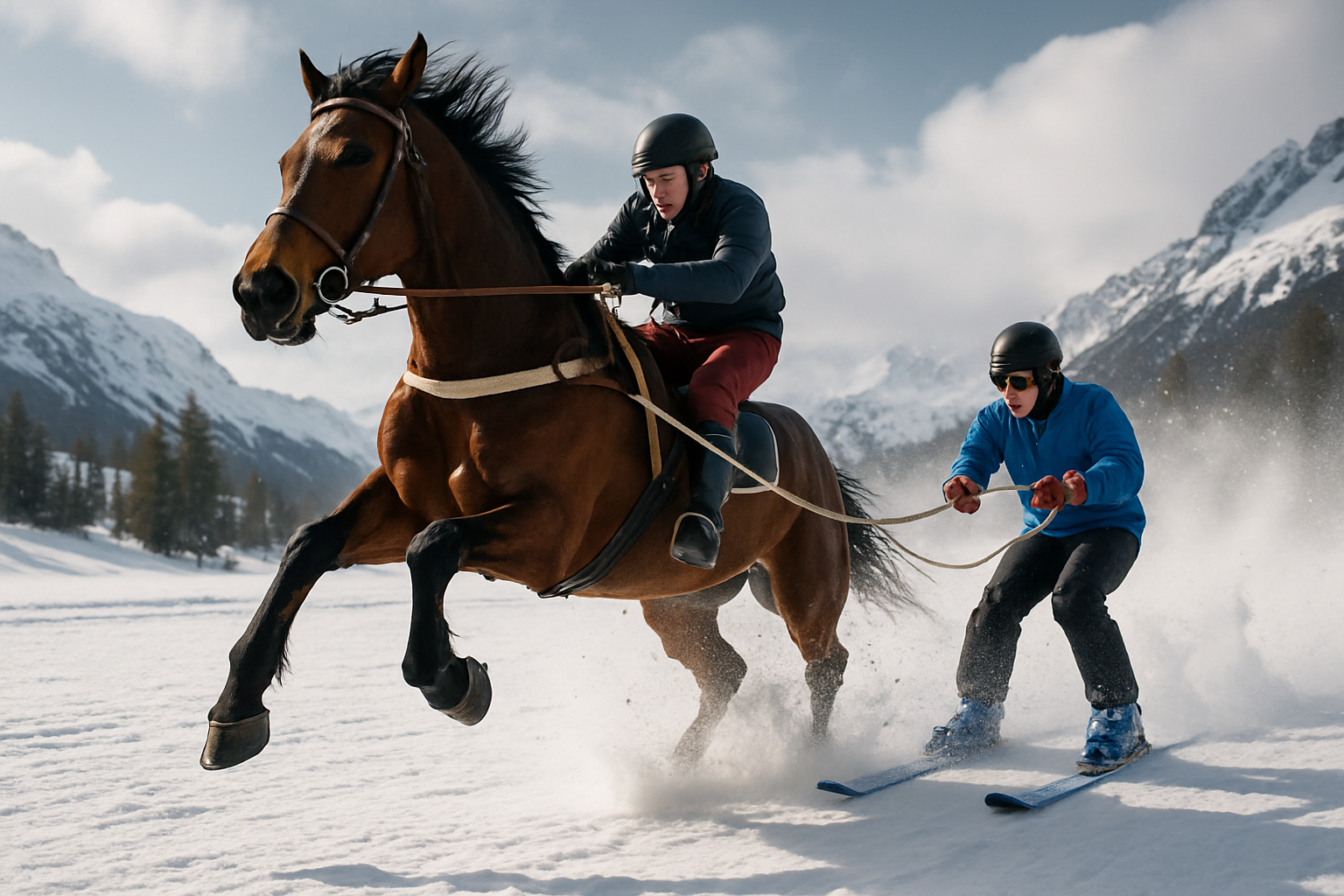Skijoring: The Thrilling Winter Sport Blending Equestrian Skills and Nordic Skiing
Imagine gliding across a snow-covered landscape, propelled by the power of a horse, the rush of wind against your face as you navigate obstacles and execute precision turns. This is the essence of skijoring, a unique winter sport that combines the grace of horseback riding with the exhilaration of Nordic skiing. Born from necessity in Scandinavia and evolved into a competitive pursuit, skijoring offers a fresh perspective on winter athletics, challenging participants to master both equestrian and skiing skills simultaneously.

The transition from practical transportation to competitive sport occurred in the early 20th century. Switzerland played a pivotal role in this evolution, hosting the first recorded skijoring competition in 1906. The sport gained significant traction, even making an appearance as a demonstration event at the 1928 Winter Olympics in St. Moritz, Switzerland.
Today, skijoring has expanded beyond its Nordic origins, finding enthusiasts in North America, particularly in states like Montana, Colorado, and Wyoming. The sport has diversified, with variations including dog skijoring and even motorized skijoring using snowmobiles, though horse-drawn skijoring remains the most popular and traditional form.
The Mechanics of Skijoring
At its core, skijoring involves a skier being pulled by a horse and rider through a snowy course. The skier, equipped with standard Nordic skis, holds onto a rope attached to the horse’s harness. This setup requires a delicate balance of communication and coordination between the horse, rider, and skier.
The skier must maintain a strong stance, using their ski edges to control direction and speed while being pulled at velocities that can exceed 40 miles per hour. The rider’s role is equally crucial, guiding the horse through the course while being mindful of the skier’s position and safety.
Courses typically feature a variety of obstacles and challenges, including slalom gates, jumps, and rings that the skier must collect while in motion. These elements test the team’s agility, speed, and precision, making skijoring a multifaceted sport that demands skill from all participants.
Training for Skijoring: A Dual-Discipline Approach
Preparing for skijoring requires a unique training regimen that addresses both equestrian and skiing skills. For the rider, developing a strong bond with the horse is paramount. This involves extensive training in horseback riding, with a focus on maintaining control at high speeds and in varied snow conditions.
Skiers must hone their Nordic skiing techniques, particularly in areas of balance, edging, and quick directional changes. Additionally, they need to develop upper body strength to manage the rope and withstand the pulling force of the horse.
Cross-training plays a significant role in skijoring preparation. Many athletes incorporate exercises that improve core strength, leg power, and overall endurance. Activities such as trail running, mountain biking, and strength training are common among skijoring enthusiasts during the off-season.
Perhaps the most critical aspect of training is the synergy between horse, rider, and skier. Practice sessions focus on developing clear communication systems, usually involving a combination of verbal commands and physical cues. This teamwork is essential for navigating courses safely and effectively.
The Global Skijoring Community
While skijoring remains a niche sport, it boasts a passionate and growing community of practitioners and fans. Annual competitions draw participants from around the world, with events ranging from local gatherings to international championships.
The World Skijoring Championships, held annually in Whitefish, Montana, serves as a pinnacle event for the sport. This competition attracts top teams from across North America and Europe, showcasing the highest level of skijoring skill and excitement.
Beyond competitive events, skijoring has fostered a tight-knit community of enthusiasts who share a love for winter sports, horses, and outdoor adventure. Many ski resorts and equestrian centers now offer skijoring lessons and experiences, introducing newcomers to this unique winter activity.
Equipment and Safety Considerations
Specialized equipment plays a crucial role in skijoring, blending elements from both skiing and equestrianism. Skiers typically use Nordic skis, though some prefer alpine skis for added stability. The rope connecting the skier to the horse is usually about 30 feet long and includes a quick-release mechanism for safety.
Horses are fitted with special harnesses designed to distribute the pulling force evenly and comfortably. Some competitive horses even wear specialized horseshoes with extra traction for better grip on snow and ice.
Safety is paramount in skijoring, given the high speeds and potential for unpredictable situations. Helmets are mandatory for both riders and skiers, and many participants opt for additional protective gear such as goggles, knee pads, and back protectors.
Course design also plays a significant role in safety considerations. Organizers must carefully plan layouts to minimize risks, ensuring adequate space for turns and positioning obstacles to reduce the chances of collisions or falls.
The Physical and Mental Benefits of Skijoring
Engaging in skijoring offers a range of physical and mental health benefits. Physically, it provides an intense full-body workout, engaging core muscles, legs, and upper body simultaneously. The sport’s dynamic nature also improves balance, coordination, and reflexes.
Mentally, skijoring offers unique challenges that can enhance cognitive function and emotional well-being. The need for quick decision-making and constant communication with team members sharpens mental acuity and promotes focus. Additionally, the thrill of the sport and the connection with nature can provide significant stress relief and boost overall mood.
The social aspect of skijoring should not be underestimated. Participating in this sport often involves joining a community, fostering friendships, and developing a sense of belonging. This social connection can have profound positive effects on mental health and personal satisfaction.
Environmental Considerations and Sustainable Practices
As with any outdoor sport, skijoring has an environmental impact that practitioners and event organizers must consider. The use of horses and the need for snowy conditions raise questions about sustainability and responsible land use.
Many skijoring communities have adopted eco-friendly practices to minimize their environmental footprint. These include using biodegradable materials for course markers, implementing waste management systems at events, and promoting responsible horse care practices.
Climate change poses a significant challenge to winter sports, including skijoring. Shorter snow seasons and unpredictable weather patterns have led some communities to explore adaptive strategies, such as artificial snow production or adjusting event schedules to align with optimal snow conditions.
The Future of Skijoring: Innovations and Expansions
As skijoring continues to evolve, several trends and innovations are shaping its future. Technology is playing an increasingly important role, with GPS tracking systems now used in some competitions to provide real-time data on speed and performance. This not only enhances the spectator experience but also offers valuable insights for athletes and trainers.
Virtual reality (VR) and augmented reality (AR) technologies are being explored as training tools, allowing skiers to practice course navigation and timing without the need for snow or horses. While these cannot replace real-world experience, they offer valuable supplementary training options, especially during off-seasons or in regions with limited snow.
Efforts to expand skijoring’s global reach are ongoing. Initiatives to introduce the sport to new regions, particularly in Asia and Southern Hemisphere countries with suitable winter conditions, are underway. These efforts often involve cultural exchanges, with experienced skijorers traveling to new areas to demonstrate and teach the sport.
Competitive Strategies and Techniques
Success in competitive skijoring requires a combination of speed, precision, and teamwork. Top competitors employ various strategies to gain an edge in races. One key technique is the “slingshot” maneuver, where the skier uses the horse’s momentum to propel themselves around tight turns, minimizing loss of speed.
Timing is crucial in skijoring, particularly when approaching jumps or obstacles. Skilled skiers learn to read the horse’s gait and anticipate changes in speed or direction. This synchronization between horse, rider, and skier can make the difference between a smooth run and a disqualification.
In team events, where multiple horses and skiers compete simultaneously, strategic positioning becomes vital. Teams must navigate not only the course obstacles but also their competitors, requiring split-second decision-making and excellent spatial awareness.
The Role of Breeds in Skijoring
While various horse breeds participate in skijoring, certain characteristics are particularly valued. Quarter Horses are popular for their strength and agility, while Thoroughbreds are prized for their speed. Some enthusiasts prefer draft horse crosses, which combine power with a calm temperament.
The ideal skijoring horse possesses a combination of speed, stamina, and tractability. They must be comfortable working in cold conditions and remain calm in the face of unfamiliar obstacles and sounds. Training a skijoring horse often begins with desensitization exercises, gradually introducing the animal to the equipment and conditions they’ll encounter during events.
Interestingly, the relationship between horse and rider in skijoring often extends beyond the sport itself. Many competitive teams consist of riders and their personal horses, highlighting the deep bond and trust necessary for success in this unique discipline.
Cultural Impact and Artistic Representation
Skijoring has left its mark on culture and art, particularly in regions where it has deep historical roots. In Switzerland and parts of Scandinavia, skijoring scenes have been depicted in traditional artwork, capturing the sport’s elegance and excitement.
Modern artists and photographers have also found inspiration in skijoring, creating dynamic works that showcase the sport’s blend of power and grace. These artistic representations help to raise awareness of skijoring and attract new enthusiasts to the sport.
In literature and film, skijoring has made appearances in works set in winter landscapes, often symbolizing freedom, adventure, and the harmony between humans, animals, and nature. These portrayals contribute to the sport’s mystique and appeal to those seeking unique winter experiences.
Skijoring’s Influence on Other Sports and Activities
The principles and techniques of skijoring have influenced the development of other sports and recreational activities. Water skiing, for example, shares many similarities with skijoring, translating the concept to a summer environment. Some adventurous individuals have even experimented with “sandboarding” behind vehicles in desert environments, drawing inspiration from skijoring’s basic premise.
In the realm of dog sports, skijoring with canines has gained popularity, especially in regions where horse skijoring is less practical. This variant maintains the spirit of the original sport while adapting it to different conditions and resources.
The cross-disciplinary nature of skijoring has also inspired training methodologies in other sports. The emphasis on balance, core strength, and quick reflexes has been adopted by athletes in various winter sports, recognizing the transferable skills developed through skijoring practice.
Psychological Aspects of Skijoring
The psychological demands of skijoring are as intense as the physical requirements. Participants must develop a high level of trust – not only in their own abilities but also in their equine and human partners. This trust is crucial when moving at high speeds in potentially challenging conditions.
Fear management is another critical psychological aspect of the sport. Novice skijorers often struggle with the intimidation factor of being pulled by a powerful horse. Overcoming this fear requires mental conditioning and gradual exposure to increasingly challenging situations.
Competitive skijorers often employ visualization techniques to prepare for races. By mentally rehearsing their runs, including potential obstacles and scenarios, athletes can improve their performance and reaction times during actual events.
The Economics of Skijoring
While not as commercially developed as mainstream winter sports, skijoring has its own economic ecosystem. Specialized equipment manufacturers cater to the unique needs of the sport, producing custom harnesses, ropes, and ski adaptations.
Events can have significant economic impacts on host communities, particularly in small towns that embrace skijoring as a winter attraction. These competitions often draw tourists, boosting local hospitality and retail businesses during typically slow winter months.
Some enterprising individuals have developed skijoring-focused tourism experiences, offering guided trips that combine skiing, horseback riding, and cultural immersion in traditional skijoring regions. These niche travel offerings appeal to adventure seekers looking for unique winter experiences.
Challenges and Controversies in Skijoring
Like any sport, skijoring faces its share of challenges and controversies. Animal welfare concerns are at the forefront, with critics questioning the stress placed on horses during competitions. Proponents argue that with proper training and care, horses can safely and enjoyably participate in the sport.
Standardization of rules and competition formats is an ongoing discussion within the skijoring community. As the sport grows internationally, there’s a push for more consistent regulations to ensure fair competition across different events and regions.
Environmental impact remains a concern, particularly in areas where natural snow is becoming less reliable due to climate change. The debate over the use of artificial snow and its ecological consequences continues within the skijoring community and beyond.
Skijoring in Popular Culture
While not as prevalent in mainstream media as some other winter sports, skijoring has made appearances in various forms of popular culture. It has been featured in several documentaries exploring unique winter sports and local traditions in Nordic countries.
Social media has played a significant role in increasing skijoring’s visibility. Spectacular photos and videos of skijoring runs often go viral, introducing the sport to new audiences worldwide. This increased exposure has led to growing interest, particularly among younger generations seeking novel winter activities.
Some winter festivals and carnivals have incorporated skijoring demonstrations or competitions, further integrating the sport into broader winter culture celebrations. These events often combine traditional aspects of skijoring with modern entertainment elements, creating a unique spectator experience.
Technological Advancements in Skijoring Equipment
Innovation in equipment design continues to enhance the safety and performance aspects of skijoring. New materials are being used to create lighter, stronger ropes that reduce the risk of breakage while improving responsiveness for the skier.
Advancements in ski technology, originally developed for alpine and Nordic skiing, are being adapted for skijoring. These include improvements in edge design for better control at high speeds and in varied snow conditions.
Wearable technology is making inroads into the sport, with some competitors using smart fabrics that monitor body temperature and heart rate. This data can be used to optimize training regimens and manage exertion levels during competitions.
The Role of Veterinary Science in Skijoring
Veterinary science plays a crucial role in supporting the health and well-being of skijoring horses. Specialized equine sports medicine has developed protocols for preparing horses for the unique demands of the sport, including cardiovascular conditioning and joint health management.
Nutrition science for performance horses has been adapted to meet the specific needs of skijoring equines, considering factors such as energy requirements for short, high-intensity bursts and recovery needs in cold conditions.
Ongoing research in equine biomechanics is providing insights into how horses move and perform in snow, leading to improvements in training methods and equipment design to optimize performance while minimizing injury risk.
Educational Initiatives in Skijoring
As interest in skijoring grows, educational programs are emerging to promote safe and responsible participation in the sport. Some equestrian centers and ski schools now offer introductory courses, teaching the basics of both horse handling and skiing techniques specific to skijoring.
Youth programs are being developed in some regions to introduce children to skijoring in a controlled, safe environment. These initiatives often emphasize not just the athletic aspects of the sport but also environmental stewardship and animal care.
At the collegiate level, a few universities in regions where skijoring is popular have begun offering courses or club activities related to the sport. These programs often combine practical skills with academic study of the sport’s history, cultural significance, and scientific aspects.
Conclusion
Skijoring stands as a testament to human creativity in winter sports, blending age-old traditions with modern athletic prowess. Its unique combination of skiing and equestrianism offers participants and spectators alike an exhilarating experience that goes beyond conventional winter activities. As the sport continues to evolve, embracing new technologies and expanding its global reach, it maintains its core essence of harmony between human, animal, and nature.
The challenges faced by skijoring, from environmental concerns to standardization issues, are balanced by its potential for growth and the passionate community that supports it. Whether as a competitive pursuit or a recreational activity, skijoring provides a distinctive way to experience winter landscapes and push the boundaries of human-animal cooperation in sports.
As we look to the future, skijoring’s blend of tradition and innovation positions it as a fascinating niche in the world of winter sports. Its continued development and the dedication of its practitioners ensure that this unique discipline will continue to captivate and inspire for generations to come, offering a thrilling alternative for those seeking to experience the winter world in a truly extraordinary way.




